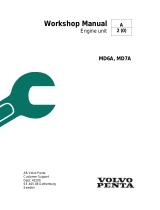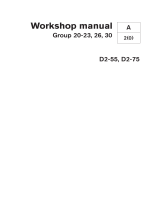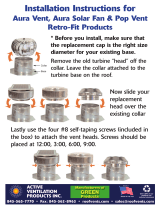
Cylinder liners and pistons, fitting ................................ 45
Sealant between the fuel injection pump bearing housing
and the cylinder block:
TAD1630/TID162/TWD1620/TWD1630/TD164KAE .... 48
TAD1631 ..................................................................... 49
Seal on output shaft from timing gear to injection pump, re-
placing:
TAD1630/TID162/TWD1620/TWD1630/TD164KAE. 50
TAD1631 ................................................................. 51
Front sealing ring for coolant pump, replacing .............. 53
Sealant, timing gear cover, replacement ...................... 54
Timing gears, removing ............................................... 55
Intermediate gears, replacing bearing .......................... 56
Timing gears, fitting ..................................................... 57
Polygon hub, replacing ................................................ 58
Sealant, transmission gear casing, replacing ............... 59
Camshaft, checking for wear....................................... 59
Camshaft, replacing .................................................... 62
Camshaft bearings, replacing ...................................... 64
Main bearings, replacing, all ........................................ 66
Crank bearings, checking for wear or replacing, all ..... 67
Crankshaft, replacing .................................................. 68
Crankshaft .................................................................. 69
Inspection ................................................................ 69
Reconditioning ......................................................... 71
Flywheel, checking for warp ........................................ 71
Flywheel, replacing...................................................... 72
Ring gear, replacing .................................................... 73
Flywheel casing, checking for warp............................. 73
Flywheel bearing, replacing ......................................... 74
Crankshaft seal, rear, replacing................................... 75
Crankshaft seal, front, replacing .................................. 76
Sealant, flywheel casing, replacing .............................. 77
Lubrication system ....................................................... 79
Design and Function .................................................... 79
General ....................................................................... 79
Oil cooler..................................................................... 81
Service procedures ...................................................... 82
Lubricating oil pressure, checking ............................... 82
Oil filters, replacing ...................................................... 82
Oil cooler, replacing..................................................... 83
Oil cooler, leakage test ................................................ 84
Oil pump, replacing...................................................... 85
Oil pump, reconditioning .............................................. 87
Contents
General Information ..................................................... 3
Tools .............................................................................. 11
Special tools................................................................ 11
Other special equipment.............................................. 15
Engine ........................................................................... 16
Design and Function .................................................... 16
Cylinder head .............................................................. 17
Cylinder block ............................................................. 17
Seals........................................................................... 17
Valve mechanism ........................................................ 18
Camshaft..................................................................... 18
Timing gears................................................................ 18
Crankshaft/pistons ...................................................... 19
Service procedures ...................................................... 20
Engine fixture, attaching .............................................. 20
Compression test ........................................................ 21
Exposing engine body ................................................. 21
TAD1630/TAD1631 ..................................................... 21
TID162/TWD1620/TWD1630/TD164 ........................... 21
TAD1630/TAD1631/TID162/TWD1630/TD164 ............ 22
Cylinder head, removing.............................................. 23
Cylinder head, disassembling ...................................... 24
Cylinder head, pressure testing ................................... 25
Cylinder head, inspection ............................................ 26
Cylinder head, face-grinding ........................................ 26
Valve guides, inspection.............................................. 27
Valve guides, replacing ............................................... 28
Valve seats, replacing ................................................. 28
Valve seats, grinding ................................................... 29
Valves, grinding........................................................... 29
Cylinder head, assembling .......................................... 30
Cylinder head, installation ............................................ 30
Rocker arm mechanism, reconditioning....................... 33
Valves, adjusting ......................................................... 34
Copper sleeve for injectors, replacing.......................... 36
Cylinder liners and pistons, removing .......................... 37
Cylinder liners, measurement and inspection............... 40
Cylinder liners, honing ................................................. 40
Cylinder liner seats, reconditioning .............................. 41
Cylinder block, face-grinding ....................................... 42
Pistons, checking ........................................................ 43
Pistons, fitting .............................................................. 43
Piston rings, inspection ............................................... 43
Connecting rods, inspection ........................................ 43
Pistons, piston rings and connecting rods,
assembling .................................................................. 44
Workshop manual
TAD1630G/GE/P/V, TAD1631G/GE, TID162AP,
TWD1620G/GH, TWD1630G/GE/P/V, TD164KAE
Contents


























